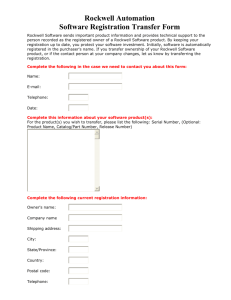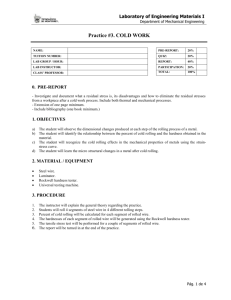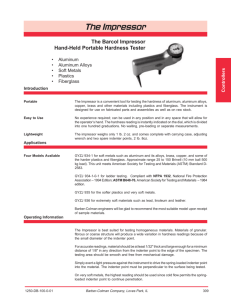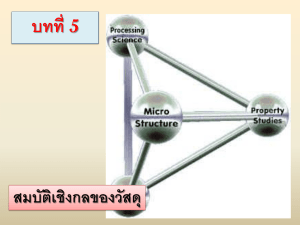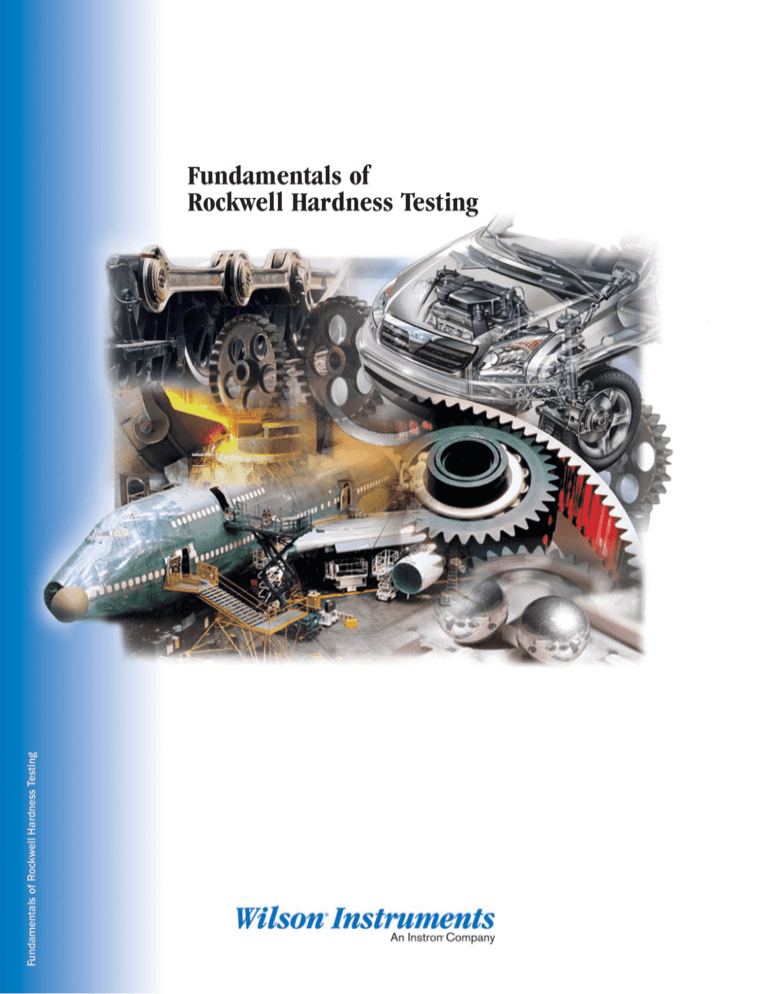
Fundamentals of Rockwell Hardness Testing
Fundamentals of
Rockwell Hardness Testing
Fundamentals of Rockwell Hardness Testing
Principle of Test
Like the Brinell, Vickers, Knoop, Scleroscope and Leeb
tests - all of which fall in the general category of indentation
hardness tests - the Rockwell test is a measure of the
resistance of material, specifically metals, to permanent
indentation. Indentation hardness is not a fundamental
property of a material. However, reliable relationships have
been established between the various tests and important
properties of materials, such as tensile strength and
machinability. Furthermore, indentation hardness has
become one of the most reliable controls of the heat
treatment and quality of manufactured parts. Rockwell
testing is covered by ASTM test method E 18.
The Rockwell test consists of measuring the additional
depth to which a carbide ball or Brale diamond
penetrator is forced by a heavy (major) load beyond the
depth of a previously applied light (minor) load (SET point).
While all indentation hardness tests generally serve the
same purpose, each one has definite advantages that make
the test more applicable to certain types of materials and
part geometries. Brinell is used primarily on forgings and
cast iron. The rebound test is used on large rolls. Vickers
and Knoop tests are used on very small or thin parts and
for case depth determinations on parts such as gear tooth
profiles. The Rockwell test is the most popular indentation
hardness test and is used in a wide variety of applications.
The Brale diamond penetrator is used for testing materials
such as hardened steels and cemented carbides. The
carbide ball penetrators, available with 1/16 inch,
1
/8 inch, 1/4 inch, and 1/2 inch diameter, are used when testing
materials such as steel-copper alloys, aluminum and plastics
to name a few.
Advantages of the Rockwell Test
There are several reasons for the popularity of the Rockwell
test. The test itself is very rapid. On a manually operated
unit, a Rockwell test takes only five to ten seconds,
depending upon the size and hardness of the specimen, as
well as pre-load and dwell time. Also, the indentation is
extremely small and usually does not need to be removed
by machining, making this a non-destructive test. A
Rockwell C scale test on hardened steel, for example,
penetrates to a depth of approximately 0.0035 inch, with
the diameter of the indentation only 0.019 inch, which is
barely visible. The Rockwell test is applicable to a wide
range of part sizes. Sheet metal as thin as 0.006 inch can
be tested on the Rockwell superficial tester, and as long as
the surface area is large enough, there is no actual limitation
to the size of your specimen. The Rockwell test is based on
measurement of the depth of penetration with the hardness
number read directly from the dial gauge or digital display
that is part of every tester. In comparison, tests such as the
Brinell and Knoop require optical measurement of the
diameter and length respectively. Direct indication of the
Rockwell hardness number is possible only because of the
unique feature of the application of the minor load
(preliminary test force) which seats the penetrator in the
work and establishes a reference or SET position from
which the depth of penetration under the heavier or major
load (total test force) can be measured. This SET point
establishes the same starting point with every specimen.
®
The minor load is applied first and a SET position is
established on the dial gauge or displacement sensor of the
Rockwell tester. Then the major load is applied. Without
moving the piece being tested, the major load is removed
and, with the minor load still applied, the Rockwell hardness
number is automatically indicated on the dial gauge or digital
display.
Rockwell testing falls into two categories: Regular Rockwell
testing (e.g., C and B scales) and Rockwell superficial
testing (e.g., 30 N and 30 T scales).
High Rockwell hardness numbers represent hard materials
and low numbers soft materials.
®
2
d
Brale is Wilson®'s trademark for a diamond penetrator with a conical shape, an
included angle of 120 °, and a spherical tip with a radius of 0.200 mm, all in
accordance with ASTM E 18.
www.wilsoninstruments.com
Regular Rockwell Testing
In regular Rockwell testing the minor load is always 10 kgf
(kilograms of force). The major load can be any of the
following loads: 60 kgf, 100 kgf or 150 kgf.
No Rockwell hardness value is specified by a number alone.
It must always be prefixed by a letter signifying the value of
the major load and type of penetrator (e.g. HRC 35). A
letter has been assigned for every possible combination of
load and penetrator, as given in Table 1. Each test yields a
Rockwell hardness value on your tester. Testers with dial
gauges have two sets of figures: red and black. When the
Brale diamond penetrator is used, the readings are taken
from the black divisions. When testing with any of the ball
penetrators, the readings are taken from the red divisions.
Testers with digital displays have a scale selection switch,
allowing an automatic display of the Rockwell hardness
number on its screen.
®
The regular Rockwell scales are established such that an
infinitely hard material will read 100 on the diamond
penetrator scales and 130 on the ball penetrator scales.
One regular Rockwell number represents a penetration of
0.002 mm (0.000080 inch). Therefore, a reading of C60
indicates penetration from minor to major load of
(100 to 60 Rockwell points) x 0.002 mm = 0.080 mm or
0.0032 inch. A reading of B80 indicates a penetration of
(130 to 80 Rockwell points) x 0.002 = 0.100 mm or 0.004 inch.
Superficial Rockwell Testing
In superficial Rockwell testing the minor load is always
3 kgf. The major load can be one of the following loads:
15 kgf, 30kgf or 45 kgf. As with the regular scales, a
scale designation has been assigned for every possible
combination of load and penetrator as given in Table 2.
Infinitely hard material will read 100 on both the diamond
and ball penetrator superficial scales. One superficial
Rockwell number represents a penetration of 0.001 mm
(0.000040 inch).
Scale Symbol
Penetrator
Load in
Kilograms- Force
Scale Symbol
Penetrator
Load in
Kilograms- Force
A*
Brale *
60
15 N
N Brale
15
B
1
/16 in ball
100
30 N
N Brale
30
C
Brale
150
45 N
N Brale
45
D
Brale
100
15 T
1
/16 in ball
15
E
1
/8 in ball
100
30 T
1
/16 in ball
30
F
1
/16 in ball
60
45 T
1
/16 in ball
45
G
1
/16 in ball
150
15 W
1
/8 in ball
15
H
1
/8 in ball
60
30 W
1
/8 in ball
30
K
1
/8 in ball
150
45 W
1
/8 in ball
45
L
1
/4 in ball
60
15 X
1
/4 in ball
15
M
1
/4 in ball
100
30 X
1
/4 in ball
30
P
1
/4 in ball
150
45 X
1
/4 in ball
45
R
1
/2 in ball
60
15 Y
1
/2 in ball
15
S
1
/2 in ball
100
30 Y
1
/2 in ball
30
V
1
/2 in ball
150
45 Y
1
/2 in ball
45
d
®
Table 1: Regular Rockwell scales.
* Two scales- cabide and steel.
d
Table 2: Superficial Rockwell scales.
www.wilsoninstruments.com
3
Selecting the Proper Scale
In many instances Rockwell hardness tolerances are
indicated on drawings. At times, however, the Rockwell
scale must be selected to suit a given set of circumstances.
Many Rockwell applications are covered by the B and C
scales, which are used for testing steel and copper as well
as their alloys. The ever-increasing use of materials other
than steel and brass, as well as thin materials, is making it
even more important to have some basic knowledge of the
factors that must be considered in choosing the scale that
will assure an accurate Rockwell test.
The choice is not only between the regular hardness tester
and superficial hardness tester, with three different major
loads for each, but also between the diamond penetrator
and the steel and carbide ball penetrators - a combination
of 30 different scales.
A valuable source of information pertaining to Rockwell
scales in use by industry on a wide variety of materials is
the American Society for Testing and Materials
(www.astm.org). Many specifications will be found under
both ferrous and non-ferrous metals in which the
applicable Rockwell scale is given. In some cases
tolerances are also stated.
In the event no specification exists or there is doubt about
the suitability of the specified scale, an analysis should be
made of four controlling factors important in the selection
of the proper scale. These factors are found in the
following categories:
h Type of material
h
Thickness of specimen
h
Width of area to be tested
h
Scale limitations
Types of material included in ASTM Designation E 18 is a
listing of all regular Rockwell scales and typical materials for
which these scales are applicable. This table provides an
excellent starting point for choosing the correct scale, load
and penetrator to be used for your test (Table 3).
While Table 3 includes only the regular Rockwell scales, this
information can be a helpful guide even when one of the
superficial scales may be required. For example, note that
the C, A and D scales are used on hard materials such as
steel and tungsten carbide. Any material in this hardness
category would be tested with the diamond penetrator. The
choice to be made is whether the C, A, D, 45 N, 30 N or the
15 N scale is applicable. In any event, the possible scales
have been reduced to six. The next step is to find the scale,
whether it be regular or superficial, which will guarantee
accuracy, sensitivity and repeatability. This will normally be
determined by a sample size, thickness and hardness.
Testing under the correct conditions is the objective of any
measuring instrument, particularly the Rockwell tester.
®
Scale Symbol
Typical Applications of Scales
B
Copper alloys, soft steels, aluminum
alloys, malleable iron, etc.
C
Steel, hard cast irons, pearlitic malleable
iron, titanium, deep case hardened steel
and other materials harder than B 100
A
Cemented carbides, thin steel and shallow
case hardened steel
D
Thin steel and medium case hardened
steel and pearlitic malleable iron
E
Cast iron, aluminum and magnesium
alloys, bearing metals
F
Annealed copper alloys, thin soft
sheet metals
G
Phospor bronze, beryllium copper,
malleable irons, Upper limit G 92 to avoid
possible flattening of ball
H
Aluminum, zinc lead
K
L
M
P
R
S
V
Bearing metals and other very soft or thin
materials, including plastics
(see ASTM D 785).
Use smallest ball and heaviest load that
do not give anvil effect
d
Table 3: Typical scale applications.
4
www.wilsoninstruments.com
Thickness of Specimen
The material immediately surrounding a Rockwell
indentation is considered ‘cold-worked’. The extent of the
cold-worked area depends on the type of material and
previous work hardening of the test specimen. The depth
of material affected has been found by extensive
experimentation to be on the order of 10 times the depth of
the indentation. Therefore, unless the thickness of the
material being tested is at least 10 times the depth of the
indentation, an accurate Rockwell test cannot be expected.
This ‘minimum thickness’ ratio of 10:1 should be regarded
only as an approximation.
Computation of the depth of penetration for any Rockwell
test requires only simple arithmetic, however charts exist
that display ‘minimum thickness’ values already. These
minimum thickness values (Table 5, page 13) generally do
follow the 10:1 ratio, but they are actually based on
experimental data accumulated on varying thicknesses of
low carbon steels, hardened and tempered strip steel.
A typical example of the use of the minimum thickness and
conversion tables should be helpful. Consider a
requirement to check the hardness of a strip of steel
0.014 inch thick of approximate hardness C63. According to
Table 5, material in the C63 range must be approximately
0.028 inch for an accurate Rockwell C scale test. Therefore,
this specimen should not be tested on the C scale. It is
necessary, at this point, to detemine the approximate
converted hardness on the other Rockwell scales equivalent
to C63. These values, taken from the conversion chart
(Table 6, page 14), are: D73, A83, 45 N 70 N, 30 N, 80 N,
15 N and 91.5 N.
Referring once again to Table 5, for hardened 0.014 inch
material there are only three Rockwell scales to choose
from: 45 N, 30 N and 15 N. The 45 N scale is not suitable
as the material should be at least 45 N, 74 N. On the 30 N
scale, 0.014 inch material must be at least 30 N, 80 N. On
the 15 N scale the material must be at least 15 N, 76 N.
Therefore, either the 30 N or 15 N scale may be used.
After all limiting factors have been eliminated and a choice
exists between two or more scales, the scale applying the
heavier load should be used. The heavier load will produce
a larger indentation covering a greater portion of the
material, and a Rockwell hardness number more
representative of the material.
Therefore the conversion chart will also show that a one
point difference on the HRC scale is 0.5 on the HR30 N
scale. Smaller differences in hardness can be determined
using the 30 N scale. The above approach would also apply
in determining the scale to use which would accurately
measure the correct hardness when approximate case
depth and hardness are known.
Minimum thickness charts and the 10:1 ratio serve only as
guides. After determining the Rockwell scale based on
minimum thickness values, an actual test should be made
and the surface directly beneath the indentation examined to
determine if the material was disturbed or if a bulge exists.
If so, the material was not sufficiently thick for the applied
load, resulting in a condition known as ‘anvil effect,’ and the
Rockwell scale applying the next lighter load
should be used. On softer materials the high stress
concentration due to insufficient thickness will result in
flow of the material.
When either anvil effect or flow exists the Rockwell
hardness number obtained may not be a true value. It is
not allowed to use several specimens, one on top of
the other. The slippage between the contact surfaces of the
several specimens makes a true value impossible to obtain.
The one and only exception is in the testing of plastics: use
of several thicknesses when anvil effect is present is
recommended in ASTM Designation D 785.
Specifications do exist, and in fact are in common use,
permitting minimum thickness values below those
established by the above approach. However, in most
instances these specifications are widely used and serve
the purpose of providing comparison information. An
example is ASTM Designation B 36 for brass sheet and
strip, where the Rockwell B scale is referred to for
thicknesses of 0.020 inch. and the Rockwell 30 T scale for
thicknesses of 0.012 inch for inspection purposes. For this
application, the Rockwell test is a substitution for a tensile
test for which correlation has been established on
thicknesses to 0.020 inch and 0.012 inch.
www.wilsoninstruments.com
5
When testing specimens where anvil effect exists, the
condition of the supporting surface of the anvil must be
carefully watched. After a number of tests this surface will
become marred, or a small indentation will be produced.
Either condition will affect the Rockwell test, since under
the major load the test material will sink into the indentation
in the anvil and a lower reading will result. If a specimen
has been found after testing to be too thin, the anvil surface
should be inspected and if damaged, relapped or replaced.
The anvil should not be used if it is marred.
When testing with a ball penetrator on the superficial tester
on a specimen where anvil effect or material flow is present,
a diamond spot anvil can be used in place of the standard
steel anvil. If testing is restricted to the ball penetrators and
the superficial scale loads, there is no danger of damaging
the hard diamond surface when testing thin materials.
Furthermore, with materials that flow under load the hard
polished diamond provides a somewhat standardized
frictional condition with the underside of the specimen.
Conversion
Conversion charts are of value only as a guide. Rockwell
hardness numbers should be reported on the same scale
on which the actual test was made (this is a direct reading
as opposed to a converted reading). In the event it is
absolutely necessary to report converted values, the fact
that the numbers are converted should be indicated.
Comparison between different hardness scales on a
conversion chart does not apply if the actual test was
improperly made. For example, if sheet metal is so thin that
tests made on the Rockwell B scale show bulges on the
underside of the sheet, then values of Rockwell 30 T cannot
be obtained by merely carrying those incorrect B scale
values to the chart but can only be found by actually making
a test on the 30 T scale. If an accurate 30 T scale reading
is determined by test, the conversion chart may be referred
to for the equivalent B scale hardness numbers although
the material is too thin for an accurate B scale test. Proper
use of the chart requires a valid and proper reading.
Width of Area
In addition to the limitation of indentation depth into a
specimen for a given thickness and hardness, there is also a
limiting factor on the minimum width of material. If the
indentation is placed too close to the edge of a specimen
(or too close to another indent), the material will yield and the
Rockwell hardness number will decrease accordingly.
Experience has shown that to assure an accurate test, the
distance from the center of the indentation to the edge of
the specimen must be at least 21/2 diameters. Therefore,
when testing in a narrow area, the width of this area must
be at least five diameters when the indentation is placed in
the center. The appropriate scale must be selected for this
minimum width. While the diameter of the indentation can
be calculated, for practical purposes the minimum distance
can be determined by an indentation hardness test ‘cold
works’ the surrounding material. If another indentation is
placed within this cold worked area, the Rockwell hardness
test will be affected. Usually the readings will be higher
than obtained on the virgin material. Experience tells us the
distance from center to center of indentations must be at
least three diameters. Usually the softer the material, the
more critical the spacing, but three diameters will be
sufficient for most materials.
6
d
Wilson Rockwell® 2000 series tester performing hardness test on sheet using diamond
spot anvil.
®
www.wilsoninstruments.com
Scale Limitations
Specimen Support
Use of the diamond penetrator when readings fall below
HRC20 is not recommended since there is loss of
sensitivity. Brale diamond penetrators are not calibrated
below HRC25. If used on softer materials there may not be
agreement in results when replacing the penetrators.
Another scale should be used, for example, the B scale.
It is important for the accuracy of the test that the specimen
be held securely during the application of the major load.
Consider that one regular Rockwell hardness number
represents a vertical movement of the penetrator of
approximately 80 millionths of an inch (0.000080 inch) and
one superficial Rockwell number approximately 40 millionths
of an inch (0.000040 inch). A vertical shift of the part being
tested of only 0.001 inch will lower the Rockwell reading by
more than 10 numbers on the regular and 20 numbers on
the superficial scale.
®
There is no limitation to the hardest material that can be
tested with the diamond penetrator. However, the C scale
should not be used on tungsten carbide. The material will
fracture, or the diamond life will be considerably reduced.
The A scale is the accepted scale in use today by the
carbide industry. The carbide A scale indenters are
calibrated to the hardness levels maintained by the CCPA
(Cemented Carbide Producers Association) and therefore
give different readings than normal HRA Steel Brales.
Although scales using the ball penetrator (for example, the
B scale) range to 130, readings above approximately 100
should be done with caution. In this region, due to the blunt
shape of the penetrator, the sensitivity of most scales is
poor. Also, with the smaller diameter penetrator there is
danger of flattening the ball under the high pressure
developed on the small area of contact. If values above
100 are obtained, the next heavier load or next smaller
penetrator should be used. If readings below zero are
obtained, the next lighter load or larger penetrator should
be used. Carbide balls are now used for Rockwell testing.
The harder carbide balls are less likely to be damaged by
readings over 100.
Readings below zero are not recommended on any
Rockwell scale, primarily due to the confusion and possible
misinterpretation that can result from the use of
negative values.
Sheet metal, small pieces or other pieces that do not have
flat supporting surfaces are tested on the pedestal spot
anvil, which has a small elevated flat surface.
An anvil with a large flat surface should be used for
supporting large parts. Anvils with a supporting surface
greater than approximately three inches in diameter should
be attached to the elevating screw by a threaded section
rather than inserted in the anvil hole in the elevating screw.
Round work should be supported in a hardened Vee anvil or
in a cylindron anvil, which consists of two hardened parallel
cylinders. When testing small rounds, it is essential that the
center of the Vee be aligned with the center of the
penetrator. The piece must be straight.
Irregularly shaped pieces must be properly supported on
specially designed fixtures if an accurate test is to be made.
Tubes and hollow pieces must be supported by a mandrel to
ensure rigidity under the test loads. This will prevent the
tube from deforming under the major load, thus causing a
lower hardness reading.
On non-homogeneous materials a scale should be
selected which will give relatively consistent readings. If a
ball penetrator too small in diameter or too light is used
the resultant indentation will not cover an area
sufficiently representative of the material to yield consistent
hardness readings.
d
Gooseneck extension for ease of internal testing.
www.wilsoninstruments.com
7
Cylindrical Corrections
The Importance of Standardized Testing
The Rockwell test is a measure of the resistance of the
material being tested to permanent indentation. There is
less lateral support to the penetrating force on a convex
surface than on a flat surface. Consequently, the
penetrator will sink further into the material with the result
that the Rockwell hardness number will be lower on the
convex surface than on a flat piece of the same material.
For a concave surface (or ID) the opposite is true.
When two or more parties must agree on the hardness of a
material or part, it becomes vitally important that the
parties have a mutual understanding of how the test will be
performed. It is not unusual for a supplier, for example, to
promise his customer that all parts shipped will fall within a
certain hardness range. Prior to shipment, a wise supplier
performs a hardness test on the parts, either on a sampled
basis or as a 100% check. The customer normally inspects
the same parts as they are received. Unless an agreement
has been made on such things as the apparatus to be
used, preparation of the test specimen, calibration, test
procedure and method of reporting, the possibility of
disagreement is high.
Above diameters of one inch the difference is negligible but
for diameters of one inch and smaller the effect of the
curvature must be taken into consideration. Approximate
‘Cylindrical Correction Values’ will be found in Table 7. The
cylindrical corrections are added to the dial gauge or digital
display reading when testing on the OD (convex surface) and
subtracted when testing on the ID (concave surface). On
diameters down to 1/4 inch the regular Rockwell scales can
be used; the superficial scales can by used to 1/8 inch.
Below 1/8 inch cylindrical corrections are not available nor is
Rockwell testing normally recommended. The Knoop
hardness test is preferred on diameters under 1/8 inch.
To avoid the problem of curvature, a flat can be ground in
the area to be tested. But in doing so, extreme care must
be exercised not to affect the hardness of the part, and the
ground area must provide the minimum 21/2 inch diameter
distance from the center of the indentation to the edge of
the flat.
Only results obtained on flat surfaces or values corrected
for curvature should be used when referring to conversion
charts. When testing small diameter work, alignment of the
piece with the penetrator is vital. The smaller the diameter,
the more critical this alignment becomes.
d
d
Standard V.
Shallow V.
Most companies look to recognized standards organizations
to provide this information. These standards organizations
generally form committees to pool the knowledge and
experience of users from various industries and formulate
detailed written standards. In the U.S., the American
Society for Testing and Materials has prepared ASTM
Designation E 18 entitled 'Standard Methods for
Rockwell Hardness and Rockwell Superficial Hardness of
Metallic Materials.’ This has become the recognized
standard for Rockwell testing in the United States and many
countries around the world. The comparable ISO Standard
is 6508.
In some cases, testers may be used, which for reasons of
speed or portability, do not perform a standard Rockwell
test. Caution should be exercised when reporting results
from these testers, as the readings may not be identical to
those made on a standard Rockwell hardness tester for all
scales, materials, or part geometries.
®
d
Cylindron.
d
d
Plane.
Spot.
d
d
Diamond spot anvil.
8
www.wilsoninstruments.com
Gooseneck.
Standardized Test Blocks
If a tester is in constant use, verifying your tester with test
blocks should be a daily procedure. This check indicates
if the tester is out of calibration or if the penetrator
is damaged.
If a tester is used throughout a given scale, the
recommended practice is to check it at the high, low and
middle range of this scale. For example, to check the
complete C scale, the tester should be checked at C63,
C45 and C25. If, on the other hand, only one or two ranges
are used, test blocks should be chosen which fall within ±5
hardness numbers on any scale using the diamond
penetrator and ±10 numbers on any scale using the
ball penetrator.
A minimum of five tests should be made on the
standardized surface of the block and the average must fall
within the tolerances indicated on the block for the tester to
be considered in calibration. In addition, the spread of the
five readings (i.e., the difference between the highest and
lowest reading) must not be greater than the value specified
in Table 4 for the hardness range of the test block. Only the
standardized surface should be used, as this is the only
surface for which the values marked on the side of the
block apply.
Range of Standardized
Hardness Test Blocks
The Repeatability of the
Test Block Readings Shall
be not Greater Than:
Rockwell C Scale:
60 and Greater
Below 60
0.5
1.0
Rockwell B Scale:
45 and Greater
Below 45 to 1.5, inclusive
1.0
1.5
Rockwell A Scale:
80 and Greater
Below 80 to 60.5, inclusive
0.5
1.0
Rockwell 30 N Scale:
77.5 and Greater
Below 77.5 to 41.5, inclusive
0.7
1.0
Rockwell 30 T C Scale:
46.2 and Greater
Below 46.2 to 15.0, inclusive
1.0
1.5
Note: See ASTM E 18 for other scales.
d
Table 4: Range of test block readings.
If the average of the five readings falls outside the test block
limits, the difference between this average and the test
block average can be noted as the error of the machine, and
this error can be compensated for when evaluating
test results. Recommended practice, however, is either to
clean and examine the tester according to the instruction
manual or to call in a factory trained service representative.
Before assuming that the tester is the prime cause of
readings outside of test block limits, replace the ball in
the ball penetrator or examine the diamond point of the
diamond penetrator. Replace the penetrator if it is
damaged. Spacing of indentations on the test block
is important.
The same rule applies as when testing any material: the
distance from center to center of indentations must be
at least three diameters. The readings, usually higher,
from any indentations spaced too closely together should
be disregarded.
d
Rockwell calibration set.
www.wilsoninstruments.com
9
Apparatus
Bench Models
Stanley P. Rockwell, who was a metallurgist in a New
England ball bearing manufacturing plant, designed the
Rockwell hardness tester in 1919. At that time there was
no entirely satisfactory method for controlling the hardness
of ball bearing races and many other hardened steel parts.
As a result of his study and experiments for a means of
accurately measuring their hardness, he invented the tester
that has become known as the Rockwell hardness tester.
The word Rockwell as applied to the tester and also as
applied to test blocks has long been registered as a
trademark in the United States and many other countries.
Wilson Instruments is the original manufacturer of the
Rockwell hardness tester and Rockwell test blocks.
The bench model Rockwell testers are precision instruments
with load application, measurement, and other features
strictly in accordance with ASTM Standard E -18. The original
system was one of weights and levers, operating on a
knife-edge fulcrum, with a free-floating friction less plunger
system. The plunger rod carries the penetrator and moves
up and down within the head of the machine. Only the
penetrator contacts the surface being tested, and the point
of test is visible at all times. The most recent system is a
closed-loop system, which uses a load cell and motorized
load application. The greatest degree of hardness in a
metal that can be tested is limited only by the ability of a
diamond penetrator to withstand the stress.
The early model Rockwell tester consisted of a sturdy,
hollow cast frame, together with a plunger that held the
testing point at one end; the other end was abutted against
a delicate measuring device. A series of levers with
knife-edges connected that plunger with a weight. By
shifting the position of this weight, more or less weight was
applied to the testing point at will, to suit testing conditions.
This weight, originally called the final weight, was applied
and released by a hand lever. An elevating screw with
chuck or anvil held the work. An initial pressure was applied
by compressing a spring in the head of the machine. The
hardness was read directly as the increment of depth
caused by the increment in load as indicated by a
measuring device.
Depending upon the age of the tester, the rate of load
application is controlled either by a dashpot mechanism
or through a motorized mechanism, which is
micro-processor controlled.
Since 1919 the tester has been refined and improved.
However, the test principle remains the same. Modern
Rockwell scale hardness testers are available in the
following general categories:
h Bench models - digital and dial
Bench model testers are available in a wide range of
vertical capacities: the smallest is approximately 6 inches
and the largest as great as 14 inches. The throat depth for
most models is approximately 51/4 inches. In choosing the
vertical capacity, not only must the size of the part be
considered, but also the size of the anvil or supporting fixture.
®
®
h
Portable and mobile models
h
Automatic/production models
h
Models for special applications
Since 1993 Wilson Instruments has been owned by Instron
Corporation. As a result, a new series of Rockwell testers
have been designed using Instron’s closed loop
technology. These new closed loop instruments have
advanced Rockwell testing to a new level of accuracy
and repeatability.
Bench model testers are available for testing on the regular
or superficial scales. A combination tester, known as the
Rockwell Twintester, can perform tests on both regular and
superficial scales.
Bench model Rockwell testers can be equipped with a dial
gauge or digital display of hardness. Most manufactured
tester models are motorized for automatic application and
removal of the major load.
®
d
Hardness family.
10
www.wilsoninstruments.com
Automatic/Production Models
With the ever-increasing cost of labor and the great
emphasis on quality products, there is a growing need for
automatic hardness testers.
These limits are simply set on the control console by screw
adjustments. Colored lights indicate if the part is soft,
within limits, or too hard.
Fully-automatic systems can be custom engineered to suit
the testing requirements for a particular part. These
systems can be interfaced with an existing production line to
provide automatic and rapid Rockwell testing. The basic
component of a fully automatic test system is a test head
such as the Wilson Instruments highspeed Rockwell test
head. The Wilson Instruments high-speed Rockwell test
head performs an indentation type hardness test, using the
same principle as the standard Rockwell test.
The standard Rockwell test requires approximately three to
six seconds to complete the loading, testing and unloading
cycle. The custom high-speed hardness tester can be
designed to require less than one second to go through the
same cycle. There is considerably less time for plastic flow
of the sample during the test. This difference in time can
produce small but measurable differences in depth of
penetration between the standard Rockwell test and the
high-speed test. Therefore, the manufacturer cannot claim
that the high-speed tester performs a true Rockwell test, but
it does produce a test that gives similar results. For ease of
application, the high-speed tester is calibrated using
standard Rockwell test blocks.
®
®
The minor and major loads for the high-speed tester are
developed by feeding two known air pressures into a bellows
assembly in proper sequence. The application of a known
air pressure on a fixed air bellows will produce a known
force. The depth of penetration is measured by a unique
electronic system.
This system automatically remembers the minor load
position and the major load position and then subtracts the
two to obtain the desired result. The output has a DC voltage
that is equal to 0.1 volts per point or 10 volts full scale.
High and low hardness limit controls are included to allow
automatic hardness sorting.
d
Rockwell series 2000 tester integrated with Instron® universal test system designed for
automatic loading and testing with a robot.
www.wilsoninstruments.com
11
Portable Models
Conclusion
Many different types of portable testers are available. The
ideal choice is the tester that handles the job for which it
is intended while providing the degree of accuracy required.
Because of the limitations imposed on the design to keep
weight to a minimum, portable hardness testers are not as
a rule as accurate as bench model testers, therefore, they
should only be considered when the part cannot be easily
brought to the tester. In fact, some designs do not operate
on the Rockwell principle, but they are usually graduated in
'equivalent Rockwell C scale hardness number' and as such
are of the order of accuracy of a conversion chart.
The Rockwell tester, while a rugged piece of equipment, is
also a precision instrument with many features suitable for
production testing. To utilize this instrument to its full
potential, consideration must be given to the factors
governing selection of the appropriate scale as well as the
curvature of the specimen and the importance of adequate
support under test. With all limiting factors taken into
account and with properly designed equipment in good
calibration, the Rockwell test can be a versatile procedure
capable of measuring small differences in hardness.
Several portable testers that follow the Rockwell principle
are available. In one such unit, the only deviation from the
procedure followed on a bench model tester is the clamping
of the part in the C clamp of the unit. The loads are
applied by calibrated springs. Many portable testers are
available for unusual applications (for example, internal
testing), and the manufacturer should be contacted for
additional information.
Models for Special Applications
Rockwell hardness testers have been designed for a
variety of special applications. The hardness of plastics can
be measured on standard digital Rockwell testers. On
certain digital Rockwell testers, dwell and recovery times
are programmable. The user can select the duration of
time during which the major load is applied (between 1 and
99 seconds) and the amount of time after removal of the
major load before the depth is measured (also between
1 and 99 seconds).
®
d
Wilson® Instruments mobile model M51.
High temperature testing can be performed with a special
Rockwell tester equipped with a furnace and temperature
recording system. Special penetrators permit testing up
to +1800 °F.
d
Custom designed frames can be built to test parts too large
for bench testers. Special testers are also available for
testing odd-shaped parts or internal or
hard-to-reach surfaces.
Wilson Instruments portable model M3.
d
Wilson Instruments model M-250 Portable LEEB type hardness
tester with printer.
12
www.wilsoninstruments.com
About Conversion Charts (Table 6)
Although conversion tables dealing with hardness can
only be approximate, it is of considerable value to be able
to compare different hardness scales. This table is based
on the assumption that the metal tested is homogeneous
to a depth several times as great as the depth of
the indentation.
The indentation hardness values measured on the various
scales depend on the work hardening behavior of the
material during the test, and this in turn depends on the
degree of previous cold working of the material. The B-scale
relationships in the table are based largely on annealed
metals for the low values and cold worked metals for the
higher values. Therefore, annealed metals of high scale
B-scale hardness, such as austenitic stainless steels, nickels
and high nickel alloys, do not conform closely to these
general tables. Neither do cold-worked metals of low
B-scale hardness, such as aluminum and softer alloys.
Special correlations are needed for more exact relationships
in these cases. Where applicable, the values are consistent
with ASTM E 140 Tables 1 and 2, and ASTM A 370
Tables 3A and 3B. All other conversions shown, including
the microficial number values, were developed in the
Wilson Instruments standards library.
®
d
Table 5: Minimum thickness chart.
X: No minimum hardness
These values are approximate only and this chart is
intended primarily as a guide. Materials thinner than
shown in this chart may be tested on the Tukon
microhardness tester. The thickness of the specimen
should be at least 1.5 times the diagonal on the
indentation when using the 136 diamond pyramid
indenter, and at least 1/2 times the long diagonal when
using the Knoop indenter.
TM
www.wilsoninstruments.com
13
d
Table 6: Conversion charts
Note 1: A 10 mm steel ball is used for 450 BHN and below.
A 10 mm carbide ball is used above 450 BHN.
Note 2: The tensile strength relation to hardness is inexact, even for steel, unless it is
determined for a specific material.
The values shown are approximate only and these charts are intended primarily as a
reference guide.
14
www.wilsoninstruments.com
Cylindrical work for correction to be added to observed
Rockwell number for scales indicated.
These corrections are approximated only and represent the
averages to the nearest 1/2 Rockwell number.
d
Table 7: Cylindrical corrrection chart 53.
www.wilsoninstruments.com
15
For information on Instron® products and services call your local worldwide sales, service and technical support offices:
Corporate Headquarters
USA
825 University Ave,
Norwood, MA 02062-2643 USA
Tel: +1 800 564 8378
+1 781 575 5000
Fax: +1 781 575 5725
North America Sales and Service Center
Sales
Tel: +1 800 695 4273 or +1 781 575 6000
Fax: +1 781 575 5770
Service and Technical Support
Tel: +1 800 473 7838
Fax: +1 781 575 5144
www.instron.com
Toronto
CANADA
Tel: +1 905 333 9123
+1 800 461 9123
Fax: +1 905 639 8683
www.wilsoninstruments.com
Instron is a registered trademark of Instron Corporation.
Other names, logos, icons and marks identifying Instron products and services referenced herein are trademarks of Instron Corporation and
may not be used without the prior written permission of Instron.
Other product and company names listed are trademarks or trade names of their respective companies.
Copyright © 2004 Instron Corporation. All rights reserved.
All of the specifications shown in this brochure are subject to change without notice.
WB1226


